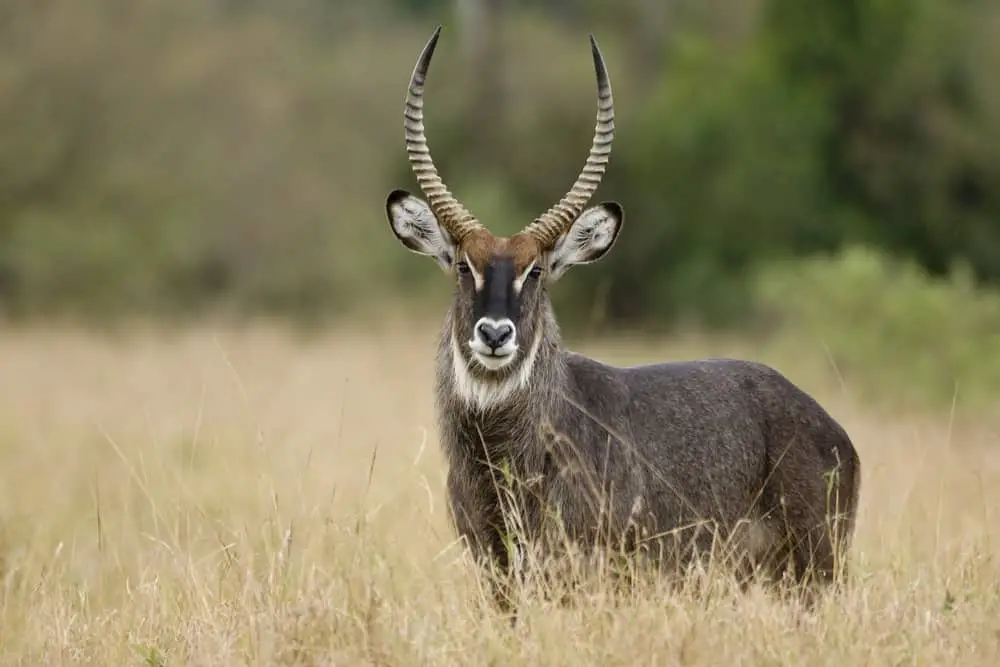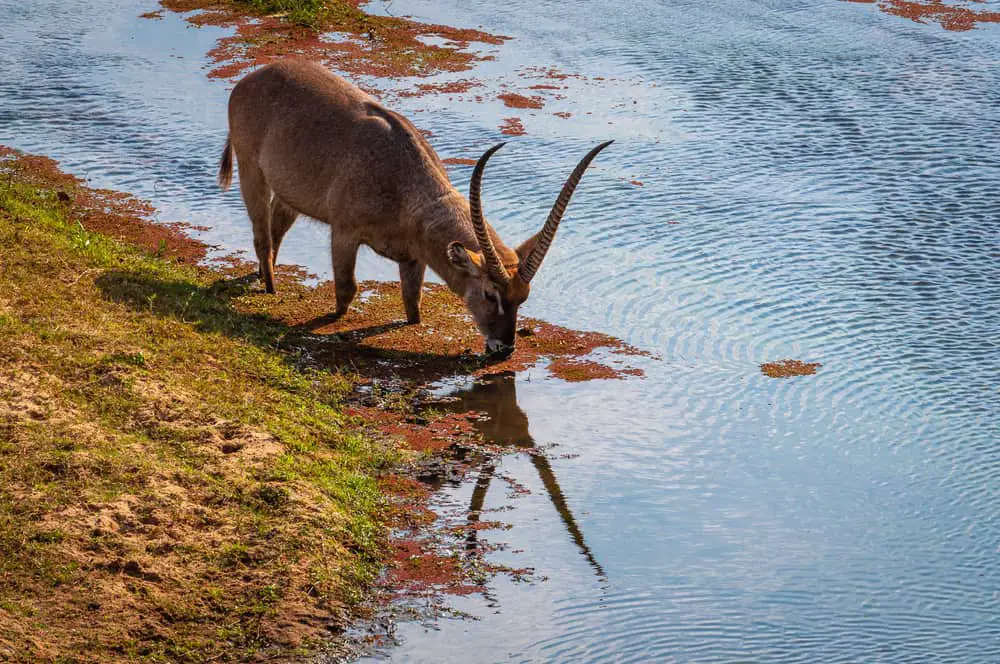The waterbuck (Kobus ellipsiprymnus) is an antelope species native to sub-Saharan Africa, primarily inhabiting savannahs and floodplains. This semi-aquatic mammal is a large ungulate that has adapted well to various habitats, including the arid regions of the continent.
An impressive feature of this animal is its ability to survive in areas with limited access to drinking water, as it can obtain hydration from plants such as reeds or grasses.
Waterbucks have unique physical characteristics that set them apart from other antelopes; they are characterized by their heavy fur coats, distinctive white circles around the eyes, and long curved horns on both males and females.
Additionally, these animals tend to be very territorial and will form noticeable guardian pairs when defending their turf. During breeding season, herds may contain up to 30 individuals but during non-breeding times groups typically consist of between 2-6 members.
Waterbucks play an important role in African ecosystems due to their habituation of coastal plains and river systems which helps maintain vegetation diversity in those areas.
They also serve as prey for several large predators such as lions and hyenas; providing food sources for these apex hunters while simultaneously helping keep populations under control. Therefore, understanding the ecology of waterbucks is essential for protecting biodiversity within the region’s affected habitats.

Habitat And Range
The waterbuck is an antelope species native to sub-Saharan Africa. It inhabits a wide range of habitats, primarily within the savanna and grassland regions of the African continent. Its natural distribution extends from Senegal in West Africa across eastwards to Somalia and south into South Africa.
Waterbucks are well adapted to living in open grasslands, both those that are heavily wooded and those without much cover. They can also be found in areas with dense bush or scrub vegetation along riversides, where they feed on shoots, fruit and leaves.
In some cases, their habitat may include wetter areas such as marshes or swamps. The waterbuck’s preference for these types of environments makes it one of the few large herbivores that thrive in semi-arid regions of the African plains.
In addition, the waterbuck has been known to take advantage of human agriculture; thus its actual range often overlaps with cultivated land. As an example, some studies have noted higher densities occurring around maize fields than other parts of their environment due to increased food availability during harvesting periods. This suggests that agricultural activities can influence population density patterns among this species over time.
Physical Characteristics
Waterbuck are medium-sized antelopes with an impressive coat. The fur is usually black or dark brown in color, and the face has a distinctive white muzzle, which can be seen from a distance. Its long ears extend outwards to catch sound waves and help it stay alert of danger when grazing. Male waterbucks also sport handsome curved horns that begin at the base of their skulls and grow upwards in a graceful arc pattern.
The most unique physical characteristic of waterbuck is its thick hide, which helps protect them against predators. It is covered with short hair that covers their entire body except for underneath the belly area where they have longer hairs extending downwards to cover their legs. Additionally, the males have more pronounced manes growing along their necks and chest areas than do females.
Both sexes of this species possess strong hooves that allow them to traverse rocky terrain as well as mudflats without difficulty. This adaptation makes them agile runners who can escape quickly if threatened by any potential danger.
Waterbuck are also known for being able to survive long periods without access to freshwater due to their ability to consume moisture from plants and trees found near riversides and swamps. Their thick coats provide insulation during cold winter months while helping keep cool during warm summer days.
Overall, the physical characteristics of waterbuck make them one of Africa’s most recognizable antelope species; they are easily identified by their striking black fur, white muzzles, long ears, curved horns, and protective hides.
Diet And Eating Habits
Waterbucks are primarily grazers and browsers, with a diet that consists mostly of grasses. They forage in open areas such as savannas, floodplains, forests and woodlands, selecting plants individually or in small groups.
During the wet season they may also consume aquatic vegetation. Waterbucks prefer to feed on fresh green plants; however, during dry periods they will also eat older standing grasses. Additionally, waterbucks supplement their diets with herbs and shrubs when available.
The dietary preferences of waterbuck vary according to season and region but generally comprise grasses (Poaceae) along with sedges (Cyperaceae). Browsing habits become more frequent during the dry season while grazing is dominant throughout most of the year.
Occasional consumption of legumes can occur depending on availability within its habitat range. The ingestion of mineral-rich earths has been reported frequently by researchers studying these animals in various parts of Africa.
In general, waterbuck have adapted well to changing habitats due to their ability to adjust their seasonal diets accordingly. By relying heavily on grass-eating behavior combined with browsing and grazing habits during the different seasons, this species has helped maintain biodiversity in many African ecosystems over time.
Impalas and Their Predators: Unmasking the Threats
Social Structure And Behaviour
Waterbucks are social animals that live in large herds of up to 100 individuals. These herds are usually composed of females and young waterbucks, with one or two older males acting as the dominant figures. Within each herd there is a well-defined social hierarchy and group dynamics, which helps maintain order within the larger population.
The main form of communication used by waterbucks is scent marking, which serves to delineate territories and establish dominance within the herd. Waterbuck calves will also produce whistles, bleats and grunts when they feel threatened or need assistance from their mothers.
The most visible behavioural trait associated with territoriality is the tendency for adult male waterbucks to engage in ritualised combat during mating season. This behaviour is part of an intricate courtship display designed to demonstrate strength and impress potential mates.
In addition to these displays of physical strength, waterbucks also utilise vocalisations such as snorts, roars, barks and squeals to communicate with other members of their herd. By understanding these different forms of communication it becomes easier to interpret the specific behaviours associated with particular situations involving waterbucks.
This knowledge can be applied not only on an individual level but also at a larger scale when considering how waterbucks interact within their social groups.
Reproduction And Life Cycle
Waterbuck reproduction is characterized by a breeding season that typically occurs from April to June, although there may be some regional variation in this timing. During the mating process, males use their horns to fight other competitors and establish dominance over females. Gestation periods last for around 8 months, resulting in 1 or 2 calves being born at one time.
Newborn calves are precocial, meaning they can walk shortly after birth and rapidly develop independence within days. Mothers provide protection through keeping newborns away from predators while grazing alone until they gain enough strength to join herd-feeding trips with their mothers. As calves grow older, they are increasingly likely to remain with the mother’s group rather than disperse if given the opportunity.
The average lifespan of waterbucks is 15 years but can reach up to 20 years under optimal conditions in captivity. While wild mortality rates vary among populations due to predation pressure and hunting, waterbucks generally have high survival rates when compared to other antelope species such as impala or kob.

Predators And Threats
Waterbuck face numerous predators, both natural and human-induced. Predator animals are the main source of risk for waterbuck populations, including large cats such as lions and cheetahs, hyenas, wild dogs, leopards and some species of vultures. Other potential predators include crocodiles, baboons, snakes and humans.
In addition to predation by other animals, waterbuck also face threats from habitat destruction due to agricultural expansion or urban development. This can lead to fragmentation of their habitats which can make it more difficult for them to find food sources or escape from predators. Loss of vegetation cover in areas inhabited by waterbucks can also increase their vulnerability to predator attacks.
Human hunting is another major threat facing waterbuck populations. Hunting has been a popular practice among many African cultures since ancient times; however this activity is now illegal in most countries due to its negative impact on wildlife populations. In some parts of Africa where laws protecting game species are not strictly enforced, hunting activities continue unabated and cause significant declines in local waterbuck numbers.
The combination of these various threats has led to population decreases throughout much of the range occupied by waterbucks. Conservation efforts must be increased in order to ensure that viable populations remain for future generations.
Conservation Status
The conservation status of the waterbuck is largely influenced by human activities. Bushmeat, poaching and illegal hunting are major threats to the species, as well as habitat loss due to agricultural expansion. Climate change has also had an adverse effect on their habitats throughout Africa.
According to surveys conducted in 2014, there was a decrease in reported sightings of the waterbuck over previous years, indicating a decline in population size across many African countries where it is found. This highlights the need for increased efforts towards conserving this species from further decline or extinction.
In order to protect waterbucks, policies must be implemented that focus on reducing these pressures and protecting their natural habitats from exploitation. For example, creating safe zones within protected areas would help reduce illegal hunting activity and provide secure breeding grounds for the species.
Furthermore, education initiatives could raise awareness about the importance of maintaining healthy ecosystems and promoting sustainable practices that do not harm wildlife populations.
Conclusion
Waterbuck are a species of antelope that inhabit areas in Africa south of the Sahara. They have adapted to many different habitats and can be found in grasslands, woodlands, savannas, river edges, swamps and floodplains.
Waterbuck have distinctive physical characteristics such as their large ears and long horns which make them easily recognizable. Their diet consists mainly of fresh vegetation but they will also eat roots, fruits and aquatic plants if necessary. In terms of social structure and behaviour, waterbuck form herds with an adult male at its centre surrounded by females along with juveniles or bachelor males who do not yet hold breeding rights.
During mating season one dominant male will mate with multiple female while other males fight for dominance within the herd. Reproduction is seasonal with calves born after a gestation period of 8-9 months.
Predators include lions, leopards, hyenas and wild dogs among others although humans pose the greatest threat due to hunting and human development encroaching on their natural habitat. The IUCN currently lists the waterbuck as Least Concern however it should still be monitored closely since any further decline could potentially threaten this iconic African species’ survival into the future.

